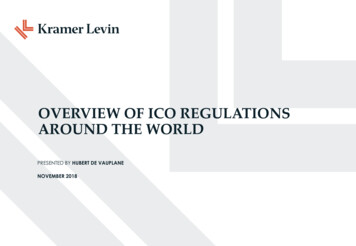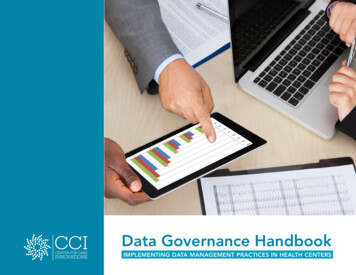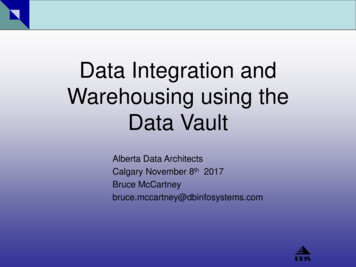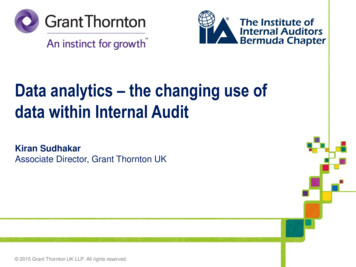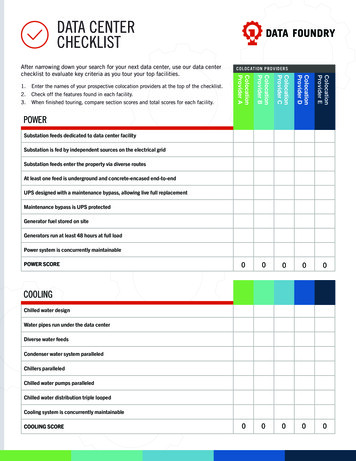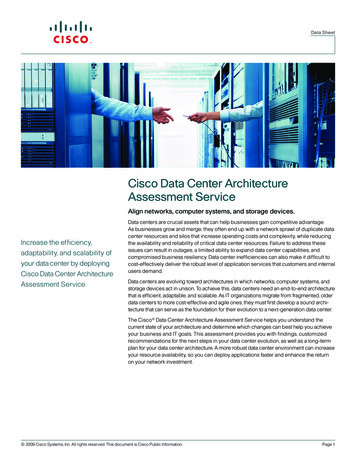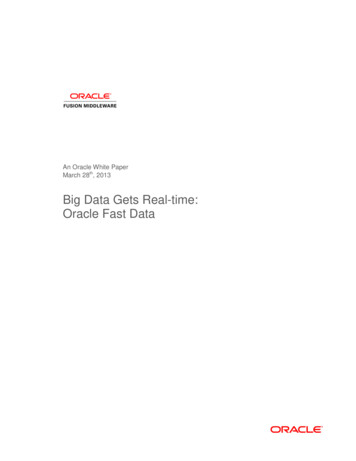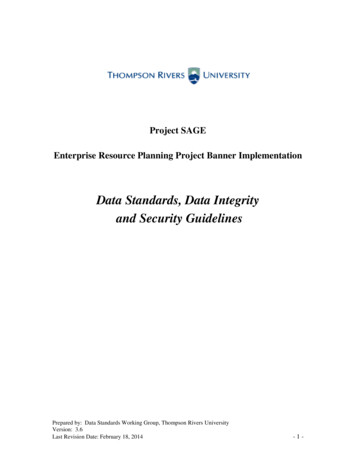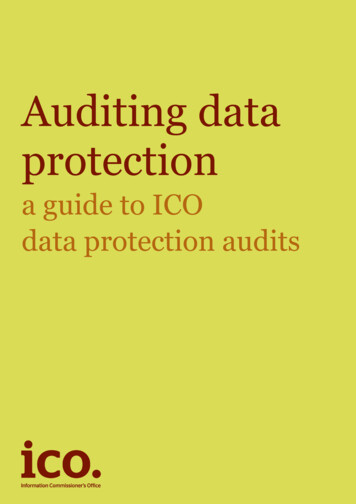
Transcription
Auditing dataprotectiona guide to ICOdata protection audits
ContentsExecutive summary31.Audit programme developmentAudit planning and risk assessment52.Audit approachGathering evidenceAudit visitDraft and final reportsPublication63.Audit follow up and reportingAudit follow upFollow up reporting94.Frequently asked questions105.Appendices1. Scope areas2. Example letter of engagement3. Example audit report4. Example follow up report13V.3.5 June 2015
Executive summaryThe Information Commissioner, who is responsible for enforcing andpromoting compliance with the Data Protection Act 1998 (the DPA), hasidentified audit as having a key role to play in educating and assistingorganisations to meet their obligations. As such, the InformationCommissioner’s Office (ICO) undertakes a programme of consensual auditsacross the public and private sector to assess their processing of personalinformation and to provide practical advice and recommendations toimprove the way organisations deal with information rights issues.Section 51 (7) of the DPA contains a provision giving the InformationCommissioner power to assess any organisation’s processing of personaldata for the following of ‘good practice’, with the agreement of the datacontroller. Good practice is defined in the DPA as practices for processingpersonal data which appear to be desirable. This includes, but is not limitedto, compliance with the requirements of the DPA. This is known as aconsensual audit.The benefits of a consensual audit include: helping to raise awareness of data protection;showing an organisation’s commitment to, and recognition of, theimportance of data protection;the opportunity to use the ICO’s resources at no expense;independent assurance of data protection policies and practices;identification of data protection risks and practical, pragmatic,organisational specific recommendations; andthe sharing of knowledge with trained, experienced, qualified staffand an improved working relationship with the ICO.The focus of the audit is to determine whether the organisation hasimplemented policies and procedures to regulate the processing of personaldata and that processing is carried out in accordance with such policies andprocedures. When an organisation complies with its requirements, it iseffectively identifying and controlling risks to prevent breaching the DPA.An audit will typically assess the organisation’s procedures, systems,records and activities in order to: ensure the appropriate policies and procedures are in place;verify that those policies and procedures are being followed;test the adequacy controls in place;detect breaches or potential breaches of compliance; andrecommend any indicated changes in control, policy and procedure.V.3.5 June 2015
The scope will be agreed prior to the audit and in consultation with theorganisation. It will take into account both generic data protection issuesas well as any organisation specific concerns about data protection policiesand procedures. It will also identify relevant data protection risks withinorganisations.The ICO proactively publishes its audit programme on the ICO website andas such the identity of organisations that agree to an audit are published.This only has basic details and does not include the agreed scope of theaudit.The ICO will make recommendations on how to mitigate the risks of noncompliance, reducing the chance of damage and distress to individuals andregulatory action being taken against the organisation for a breach of theDPA.Following completion of the audit, we will provide a comprehensive reportalong with an executive summary. The audit report provides an opportunityto respond to observations and recommendations made by the audit team.The executive summary is published on the ICO website with agreementfrom the organisation. Examples of executive summaries can be seen onthe ‘evaluating good practice’ pages of the ICO website.The ICO also has the power to conduct compulsory audits, under section41a of the DPA. This enables the Information Commissioner to servegovernment departments, designated public authorities and othercategories of designated persons with a compulsory ‘assessment notice’ toevaluate their compliance with the data protection principles. Theassessment notices code of practice provides further guidance oncompulsory audits.V.3.5 June 2015
1. Audit programme developmentAudit planning and risk assessmentIn line with the Regulators’ Compliance Code, the InformationCommissioner has adopted a risk-based, proportionate and targetedapproach to audit activities. This approach takes account of the CharteredInstitute of Internal Auditors standards of risk-based auditing. This allowsICO auditors to focus on organisations striving to comply with the DPA, butwhere there is a risk of failure. To identify high-risk data controllers andsectors the ICO uses a number of sources, including: business intelligence such as news items;data controllers’ annual statements on control and other publiclyavailable information;the number and nature of complaints received by the InformationCommissioner; andother relevant information.From the risk analysis a programme of audits will be developed. Datacontrollers volunteering for audit will also be considered for the programmein line with the risks their processing activities raise and subject toresource availability.Audit planning risk assessment, in line with the Hampton Reviewrecommendations and the Regulators’ Compliance Code, will be based on: the potential impact of non compliance; andthe likelihood of non compliance.In determining the risks of non compliance one or more of the followingfactors will be considered: the compliance ‘history’ of the data controller based on complaintsmade to the Information Commissioner and the data controller’sresponses;‘self reported’ breaches and the remedial actions identified by datacontrollers;communications with the data controller which highlight a lack ofcompliance controls and/or a weak understanding of the DPA inrespect of the principles;business intelligence such as news items in the public domain whichhighlight problems in the processing of personal data by the datacontroller and information from other regulators;statements of internal control and/or other information published bythe data controller which highlights issues in the processing ofpersonal data;V.3.5 June 2015
internal or external audits conducted on data controllers related todata protection and the processing of personal data;notification details and history;the implementation of new systems or processes where there is apublic concern that privacy may be at risk;the volume and nature of personal data being processed;evidence of recognised and relevant external accreditation;the perceived impact on individuals of any potential non compliance;andother relevant information e.g. reports by ‘whistleblowers’, andprivacy impact assessments carried out by the data controller.In determining the impact on individuals the following are taken intoconsideration: the number of individuals potentially affected; the natureand sensitivity of the data being processed and the nature and extent ofany likely damage or distress caused by non compliance.As well as proactively approaching organisations identified through the riskassessment process, there are a number of other potential sources ofaudits: organisations which volunteer for, or request, audits;those identified as potentially benefiting from an audit by other ICOdepartments, in particular the regional offices and strategic liaison;andthose identified by enforcement investigation.These organisations are also considered on a risk basis taking into accountthe factors outlined above.2. Audit approachOnce an organisation has consented to an audit, an introductory meetingwill be arranged to discuss the audit process and the ICO audit programmewill be updated on the ICO website. A provisional time for the audit sitevisit will also be agreed by working with organisations to fit with their othercommitments and to minimise the impact on their day to day work. A draftletter of engagement will be used as an agenda at the initial meeting todevelop the scope of the audit and set appropriate timescales (seeAppendix 2).The scope will be agreed in consultation with the organisation. It will takeinto account both generic data protection issues as well as any organisationspecific concerns there may be about its data protection policies andprocedures. It will also identify relevant data protection risks within theorganisation.V.3.5 June 2015
Examples of common scope areas are: data protection governance;staff data protection training and awareness;security of personal data (manual and/or electronic);requests for personal data;information sharing;records management; andPrivacy Impact Assessments.Prior to the meeting the audit team will liaise with ICO colleagues to gainbackground and information on general themes/complaints about theorganisation that may affect the scope of the audit.Within two days of the meeting we will issue a formal letter of engagement(Appendix 2).Gathering evidencePrior to the audit visit we will request as necessary policies and proceduresthat cover the scope areas from the organisation being audited. These mayinclude data protection policy documents; operational guidance or manualsfor staff processing sensitive data; data protection training modules; riskregisters; information asset registers; information governance structuresand similar. These will be used to inform the direction of the audit visit andare reviewed at the ICO’s offices prior to the site visit.We will work with the organisation to ensure that the audit visit will beproductive by identifying appropriate key stakeholders to interview andrelevant processes to examine. These interviews will be agreed in aschedule, drawn up by the organisation in consultation with the audit team.The audit visitThe audit site visit usually takes between two and three days. At the startof the visit, we will arrange for an opening meeting with appropriatemembers of the senior management of the organisation to explain theprocess to them. This provides an opportunity to discuss any issues andanswer any questions about the process.The methodology used by the audit team during the actual visit is primarilya question/interview based approach. This is supplemented by visualinspections and examinations of selected uses of personal data within theorganisation. During the visit all auditors will make notes from interviews,observations and testing.V.3.5 June 2015
The questions asked, and evidence gathered, will depend on the scopeareas agreed in the letter of engagement. However, there are somegeneric areas which are normally covered within each scope area, andexamples of these and the evidence that the audit team might look for, iswithin Appendix 1.The most important element of an audit from the perspective of the auditteam is that access to key systems and data is provided by the auditee andthat questions posed by the audit team are answered comprehensively andaccurately.Upon completion of the audit visit, the audit team will hold a meeting withthe organisation’s key stakeholders. If any major concerns have beenidentified by the audit team, they will be highlighted at this point. As far aspossible, a general overview of the audit progress will also be given.Draft and final reportsAs detailed in the letter of engagement, the first draft report will be issuedwithin 10 working days of the site visit. The report will define and graderisks, detail findings and issues identified against those risks and providean overall audit opinion. The overall audit opinion is provided following areview of each individual scope area assessed during the visit.The organisation will be required to check the first draft for factualaccuracy and return their approval and/or any amendments to the auditteam.Following return of the first draft by the organisation, the second draftreport will encompass these amendments and also includerecommendations. The recommendations made will mitigate the risks ofnon compliance, reducing the chance of damage and distress to individualsand/or the chance of regulatory action being taken against the organisationfor a breach of the DPA. The ICO will complete and deliver the second draftwithin the timescales detailed in the letter of engagement.The report will then be issued to the organisation with a draft executivesummary. The executive summary will be a template of high level sectionstaken from the report and produced in a different format for publication.The organisation will be given 10 working days to agree the summary.The organisation will be required to agree the recommendations andcomplete an action plan indicating how, when and by whom therecommendations will be implemented. The final report (Appendix 3) willthen be issued with a request for authority to publish the executivesummary.V.3.5 June 2015
All factual inaccuracies will be amended by the audit team. Disagreementbetween the two parties may occur regarding recommendations.Ultimately, it is a matter for the ICO to determine the content of the finalreport.By its very nature a two or three day inspection of an organisationprocessing a substantial volume of personal data cannot be deemed to beconclusive. Final report findings and recommendations should always beviewed in this context. A positive final report is indicative of a level ofassurance regarding an organisation’s policies and procedures in respect ofthe DPA at a certain point in time, in relation to the agreed scope areas.The final draft of an audit report agreed by both parties is not a definitiveaccount of an organisation’s data processing activities or an endorsementof that organisation’s adherence to data protection policies.PublicationThe audit programme is published in advance. After
The audit site visit usually takes between two and three days. At the start of the visit, we will arrange for an opening meeting with appropriate members of the senior management of the organisation to explain the process to them. This provides an opportunity to discuss any issues and answer any questions about the process. The methodology used by the audit team during the actual visit is .
